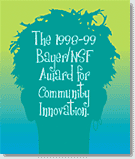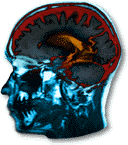 |
 Real World Innovation Real World Innovation
|
 |

Bayer/NSF Award Winners Address Problems Affecting
Millions of Americans
What do today's
young people think are some of the most critical issues
facing our communities, and how would they use science
and technology to solve them? Winners announced on
June 4 in the Bayer/NSF Award for Community Innovation
tackled real-world issues including school bus safety,
relief for arthritis sufferers and threats to the
food web. The Bayer/NSF Award challenges teams of
four middle school students to use science and technology
to identify and develop a solution to a community
issue. When a team of eighth-graders at Cold Spring
Harbor High School learned approximately one in six
Americans suffers from arthritis, they set out to
provide some relief. Their "Eazy Zap Cap" is an ingenious
device that allows arthritis sufferers and others
with limited hand mobility to open child-proof containers
without bending afflicted joints.
More...
|
 |

Massive
Pollution Documented over Indian Ocean
An international
group of scientists has documented widespread pollution
covering about 10 million square kilometers of the
tropical Indian Ocean -- roughly the same area as
the continental United States. This finding by scientists
participating in the Indian Ocean Experiment (INDOEX)
raises serious questions about what impact the extensive
pollution is having on climate processes and on marine
life in the ocean below. INDOEX, a $25 million project,
sponsored in part by the National Science Foundation,
is investigating how tiny pollutant particles called
aerosols are transported through the atmosphere, and
their resulting effect on climate.
More...
Image courtesy of the Center for Clouds, Chemistry
and Climate (C4), a National Science Foundation
Science and Technology Center, Scripps Institution
of Oceanography, University of California, San Diego
|
 |

'Altered
State' May Be Responsible for Creating Important Brain
Chemicals
Twenty years
after visualizing a surprising left-handed form of
the DNA double helix, Massachusetts Institute of Technology
researcher Alexander Rich has found that this altered
form of genetic material is involved in some important
biological activities, including creating proteins
essential for normal brain function. Rich’s work is
funded in part by the National Science Foundation
(NSF). In the 1970s, when Rich and his colleagues
solved for the first time the three-dimensional structure
of a DNA crystal fragment, they were puzzled. Instead
of looking like the right handed double helix Watson
and Crick had described in 1953, the structure was
a left-handed double helix with an irregular zig-zag
backbone.
More...
|
 |

U.S.
Industry Driving the Growth in Research & Development
Spending
Research
and development (R&D) spending in the United States
reached an estimated $220.6 billion in 1998, says
a new National Science Foundation (NSF) report. However,
the report says, industry, not government, is responsible
for most of the inflation-adjusted 5.3 percent increase
over the estimated $205.6 billion spent on R&D
in 1997. Industry has provided the largest share of
financial support for R&D in the U.S. since 1980,
said Steven Payson, author of the NSF Division of
Science Resources Studies (Special Report), National
Patterns of R&D Resources: 1998.
More...
|
 |
 
|

